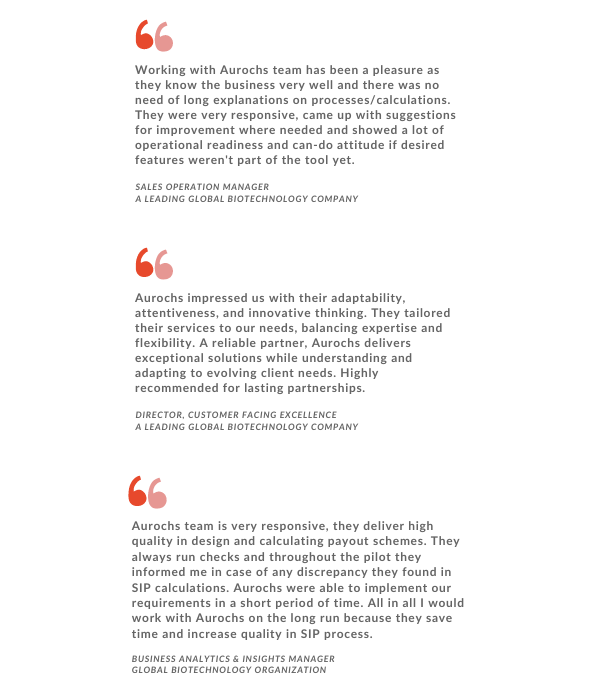In the dynamic world of sales, where competition is fierce, and targets constantly evolve, choosing the right sales incentives and commission automation solution is critical for any organization. A decision-maker must navigate many options to identify a tool that aligns with the company’s unique needs and ensures seamless operations and accurate performance reporting. In this blog, we will delve into the key considerations that decision-makers should consider when identifying the ideal solution for sales incentives and commission automation, focusing on configuration and maintenance, reporting and analytics, audit and data management, and usability.
1) Configuration & Maintenance
a) Single Tool Flexibility:
The tool’s ability to configure complex sales incentive plans is crucial. The ideal solution is to provide a single platform accommodating the diverse sales incentive structures that sales teams often require. This avoids the need for multiple tools and simplifies the overall management process.
b) Manual Adjustment Support:
The tool’s ability to configure complex sales incentive plans is crucial. The ideal solution is to provide a single platform accommodating the diverse sales incentive structures that sales teams often require. This avoids the need for multiple tools and simplifies the overall management process.
c) No Code Setup and Management:
A user-friendly system does not require coding for sales incentive plan setup and management. This feature enables quick and efficient adjustments, reducing the reliance on programmers and allowing for more agile responses to changing business needs.
d) Flexible Logic-Based Modeling:
The solution should offer flexible, logic-based modeling capabilities. It means that users can set up any commission plan without being constrained by pre-defined templates, providing the agility needed to adapt to evolving sales incentive strategies.
e) Draw and True-Up Handling:
The tool should seamlessly handle draws and true-ups, critical components of sales incentives. This ensures that sales representatives receive accurate and timely compensation based on their performance.
f) Customizable Plan Mechanics:
Customizability is key. The solution should allow for the configuration of various plan mechanics, including SPIFs (Special Performance Incentive Funds), accelerators, clawbacks, and more, to align with the definite needs and goals of the organization. Customizing these plan mechanics
ensures that sales incentive strategies are implemented effectively.
g) Differing Payment Schedules:
The ability to calculate payments on differing schedules is crucial. This feature accommodates the diverse needs of sales teams, allowing for variations in payment timing based on different performance metrics or business requirements.
h) Exception Handling:
The solution should support exception handling for employee lifecycle changes, such as promotions, departures, and new hire guarantees. During periods of organizational change, it ensures accurate calculation of compensation.

2) Reporting & Analytics
a) Basic Reporting Capability:
The chosen solution should offer basic reporting capabilities, such as providing insights into total sales incentive compensation spent per business unit. This foundational feature is essential for decision-makers to have a clear overview of the financial implications of their sales incentive plans.
b) Analytics Capabilities:
Beyond basic reporting, the tool should possess robust analytics capabilities, allowing for aggregations and the ability to slice and dice data. This empowers decision-makers to gain deeper insights into sales performance and sales incentive compensation trends.
c) Real-time Calculation Capabilities:
Real-time calculation capabilities are essential for accurate and up-to-date reporting. The solution should enable the creation of plan-level compensation calculators, providing real-time insights into the impact of different performance scenarios. This real-time data is instrumental in making informed decisions and optimizing sales incentive structures.
d) Robust Modeling Capabilities:
The tool should support robust modeling capabilities, allowing decision-makers to simulate and analyze the potential impact of changes to sales incentive plans. This feature is crucial for informed decision-making and strategic planning.
e) “What If” Calculations:
A powerful feature for decision-makers is the ability to perform “what if” calculations. This allows for the projection of sales incentives based on different revenue scenarios. It provides valuable insights into potential outcomes and helps in decision-making processes.
3) Audit & Data Management
a) Integration with Other Tools/Systems:
The chosen solution should seamlessly integrate with other tools and systems within the organization’s tech stack. This ensures a smooth data flow and reduces the risk of errors or inconsistencies. Streamlined integration maintains accurate and up-to-date data, enhancing the effectiveness of sales incentive management
b) Document Repository:
The ability to store Sales Incentive Plan (SIP) documents in a repository is crucial for compliance and record-keeping. This feature ensures that important documentation is easily accessible and organized. A centralized Sales Incentive Plans repository streamlines compliance processes and facilitates efficient record-keeping.
c) Retention of Historical Information:
Historical information is vital for trend analysis and compliance in the sales incentive process. The solution should retain historical data and payout calculations, allowing decision-makers to track performance over time and comply with auditing requirements.
d) Internal Audit Mechanism:
A robust internal audit mechanism is essential for ensuring the integrity of sales incentive processes. The solution should log changes, processing runs, approvals, and other relevant activities. This not only enhances transparency but also serves as a safeguard against errors or misuse.

4) Usability
a) Scalability:
As the organization grows, the chosen solution should be scalable to accommodate increasing data volumes and user loads. Scalability ensures the system remains efficient and responsive even as the business expands. Furthermore, it optimizes sales incentive management, fostering adaptability to evolving business needs.
b) Faster Processing Time:
Time is of the essence in sales, and a solution with faster processing times is advantageous. This improves efficiency and a positive user experience for administrators and sales associates. It also contributes to the swift and accurate processing of sales incentives, enhancing overall performance.
c) In-App Communication:
The ability to communicate about statements within the application enhances collaboration and reduces the need for external communication channels. This feature fosters a streamlined and efficient communication process.
d) Mobile App Interface:
Sales associates are often on the move, and a mobile app interface enhances accessibility. The solution should provide a user-friendly mobile app, allowing sales associates to access relevant information and perform necessary actions from anywhere.
e) Governance Workflows:
Establishing clear governance workflows is crucial for effectively managing disputes, adjustments, and changes. These workflows streamline processes, ensuring that decisions and changes follow a standardized and transparent approach.
Conclusion:
- In conclusion, selecting the right sales incentives and commission automation solution is a strategic decision that requires careful consideration of various factors.
- A solution excelling in configuration and maintenance, reporting and analytics, audit and data management, and usability empowers organizations to drive sales performance and motivate their teams.
- By considering these key considerations, decision-makers can make informed choices that align with their organization’s goals and pave the way for sustained success in the competitive sales world.

